Royal Navy LSGC Medal group. 1899 1922. RMLI Africa, Persian Gulf, Ireland

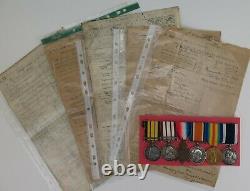
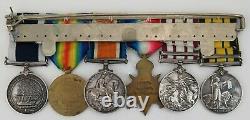
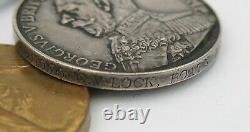
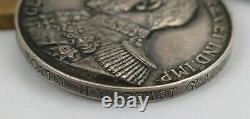
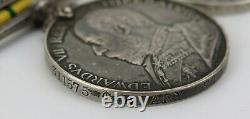
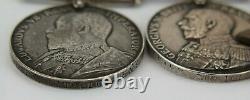
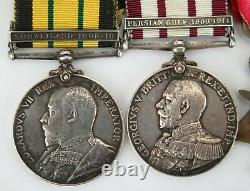
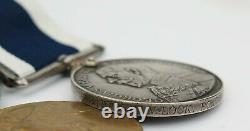
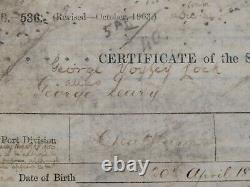
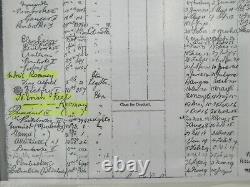
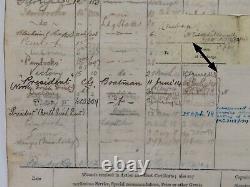

A very good group of medals to a serviceman who started out in the Royal Marines Light Infantry and transferred for a varied career to the Royal Navy. Most of his WWI service was in Ireland with the coastguard. His LSGC medal awarded during his time in Ireland is named to his alias.
The use of an alias is not easy to understand. The name Leary may have been subject to ridicule but this alias was not used when he served in the Royal Marines Light Infantry. His service in Ireland was in an area which had republican sympathies (see description below).Service certificates and extensive typed service details. Provenance: Ex Malcolm Scott Collection.
Date of Birth: 20 April 1880, Tavistock, Devon. (True date appears to be 19 Apr 1880) Occupation: Moulders Labourer. Anchor tattooed on left arm. Private:17 Apr 1899 - 20 Dec 1899.Private: 21 Dec 1899 - 10 Jul 1900. Private: 11 Jul 1900 - 10 Jun 1902.
Launched 22 Aug 1895, Commissioned 22 Nov 1896. Private: 11 Jun 1902 - 12 Jan 1903.
Private: 13 Jan 1903 - 23 Dec 1904. Launched 15 may 1897, Completed 1900. Private: 24 Dec 1904 - 16 Feb 1905.Private: 17 Feb 1905 - 31 Jul 1905. Steam screw Yacht Tender of 453 tons built in Leith and originally named Hiawatha'. Nore Gunnery School (attached to CinC Nore).
13 Aug 1905 - 28 Apr 1907 Discharged. Joined Royal Navy as Stoker 2nd Class. Stoker 2nd Class: 29 Apr 1907 - 10 May 1907. Stoker 2nd Class: 11 May 1907 - 19 Jul 1907.Launched 2 Jun 1897, Completed July 1898. Following the loss of the turbine-powered destroyer HMS. As part of these investigations, a number of full-scale tests were carried out on. To determine the stresses to which destroyers could be exposed to at sea.
Was fitted with strain gauges and subject to hogging and sagging tests in dry dock at Portsmouth. Still fitted with strain gauges, was sent to sea to look for bad weather.
The investigation indicated that the destroyers built to Admiralty design requirements had adequate strength. Stoker 2nd Class: 20 Jul 1907 - 2 Sep 1907. Launched 19 Jan 1904, Completed 5 Sep 1905. 1st Cruiser Squadron, Channel Fleet.
Stoker 2nd Class: 3 Sep 1907 - 18 Sep 1907. Stoker 2nd Class 19 Sep 1907 - 14 Aug 1908. Stoker 1st Class: 15 Aug 1908 - 12 Jan 1909.
Was a Royal Navy battleship that revolutionised naval power. Built 1905 - 1906, In Service 1906 - 1919. Dreadnought's name, and the class of battleships named after her, means "fear nothing". S entry into service in 1906 represented such an advance in naval technology that her name came to be associated with an entire generation of battleships, the "dreadnoughts", as well as the class of ships named after her. Likewise, the generation of ships she made obsolete became known as "pre-dreadnoughts".
Was the first battleship of her era to have a uniform main battery, rather than having a few large guns complemented by a heavy secondary armament of smaller guns. Her launch helped spark a naval arms race as navies around the world, particularly the German Imperial Navy, rushed to match it in the build-up to the First World War. Stoker 1st Class: 13 Jan 1909 - 12 Feb 1909. Stoker 1st Class: 13 Feb 1909 - 20 Mar 1909. Stoker 1st Class: 27 Mar 1909 - 2 Jun 1911.
Launched Became flagship of the East Indies Station in February 1907. Africa General Service Medal with Somaliland 1908-10 clasp. Was a series of military expeditions that took place between 1900 and 1920 in the Horn of Africa, pitting the Dervishes led by Mohammed Abdullah Hassan (nicknamed the "Mad Mullah", although he "was neither mad nor a mullah") against the British. By early 1908 complaints were pouring into Berbera from the interior stating that agitators were again proclaiming the right of the Mullah to be the leader of all the Somali inland tribes. The last thing that the British wanted was the expense of another campaign but something had to be done, and a decision was made to send around 1,200 KAR Askari from other Protectorates into the Somaliland interior to uphold British prestige and rule, whilst 300 Indian Sepoys arrived from Aden.First to arrive in January 1909 was Battalion Headquarters and 300 Askari of 1 KAR from Nyasaland, under Lieutenant Colonel H. In February 1909 Battalion Headquarters and 450 Askari of 3 KAR, under Lieutenant Colonel J. Graham (Corps of Guides, Indian Army), brought his 4 KAR Battalion Headquarters and 460 Askari for their 12-month stint in the Somaliland interior, returning to Uganda in February 1910. Despite not firing a shot in anger, all those troops who had served in Somaliland or off its coastline between August 1908 and January 1910 became eligible for the clasp.
To the African General Service Medal. Persian Gulf 19091914 clasp (Total awarded, 7,164, including 37 to the Army). For operations against pirates, gun-runners and slavers. Stoker 1st Class: 3 Jun 1911 - 3 Aug 1911. Stoker 1st Class: 4 Aug 1911 - 9 Sep 1912. Stoker 1st Class: 10 Sep 1912 - 19 Feb 1913 Leading Stoker: 20 Feb 1913 - 5 Mar 1913. Leading Stoker: 6 Mar 1913 - 3 Nov 1913. Launched 27 Nov 1909, Completed Jul 1909.Leading Stoker: 4 Nov 1913 - 17 Dec 1913. Leading Stoker: 18 Dec 1913 - 27 Feb 1914 Devonshire-class armoured cruiser. Launched 8 Oct 1903, Completed 23 Jun 1903. Flagship of the 3rd Cruiser Squadron of the Second Fleet.
Leading Stoker: 28 Feb 1914 - 26 Mar 1914. Leading Stoker: 27 Mar 1914 - 10 Jun 1914. London base for Coastguard ships and the Reserves. Formally HMS Buzzard moored on the River Thames, near Tower Bridge, Wapping. Boatman: 11 Jun 1914 - 31 July 1914.The Coastguard as run by the Admiralty consisted of three distinct bodies; the Shore Force, the Permanent Cruiser Force and the Guard Ships, naval ships which lay at major ports to act as headquarters of Coastguard districts. Leading Stoker: 1 Aug 1914 - 15 Oct 1914.
Launched 28 Oct 1901, Completed 22 Dec 1903. And was briefly deployed at the beginning of the war to blockade the northern exit from the North Sea. Leading Stoker: 16 Oct 1914 - 11 May 1915. (Amended at Admiralty No 9 NP/RP 19150 Wdm 22 Oct 1914). Boatman: 12 May 1915 - 25 Mar 1918.
Received LSGC medal 311575 G. 3122/1917 of 16.3.18. ADM 188/510/311575 George Learys service record.
Irish Rosmoney: Boatman: 11 Jun 1914 - 31 Jul 1914. There was a Coastguard Station there. Irish Keel: Boatman 12 May 1915 - 18 May 1915 Keel, Achill Island, Co. A British observation post was built during World War I to prevent the Germans from landing arms for the Irish Republican Army.
This may explain the use of an alias. Irish Rosmoney: Boatman: 19 May 1915 - 30 Sep 1916.
President IV London base for Coastguards. (Rosmoney): Boatman: 1 Oct 1916 - 25 Mar 1918.
United Kingdom of Great Britain and Ireland. The Irish people's experience of the war was complex and its memory of it divisive. At the outbreak of the war, most Irish people, regardless of political affiliation, supported the war in much the same way as their British counterparts, and both. Leaders initially backed the British war effort. Served extensively in the British forces, many in three specially raised divisions.
Over 200,000 men from Ireland fought in the war, in several theatres. About 30,000 died serving in. Of the British forces, and about. Took the opportunity of the ongoing war to. Proclaim an independent Irish Republic. An armed rebellion against British rule. In addition, Britain's intention to. Impose conscription in Ireland in 1918 provoked widespread resistance. And as a result remained unimplemented. Leading Stoker 26 Mar 1918 - 2 Aug 1918.Gunner, Auxiliary patrol base, Granton, Edinburgh. Leading Stoker: 3 Aug 1918 - 26 Nov 1918.
HMS Munlochy was one of 114 Hunt-class minesweepers. Ganges, Shore establishment, Shotley Suffolk for training boys. : Leading Stoker: 27 Nov 1918 - 31 Dec 1918.
Attentive III (Shore establishment, Dover). Leading Stoker: 1 Jan 1919 - 4 Feb 1919. Leading Stoker: 5 Feb 1919 - 8 Apr 1919. Leading Stoker: 9 Apr 1919 - 25 Sep 1919. Launched 27 Jul 1907, Completed Feb 1909. Leading Stoker: 26 Sep 1919 - 3 Nov 1919. Columbine, Port Edgar, Firth of Forth.Leading Stoker: 4 Nov 1919 - 13 Jul 1921. Launched 31 Jan 1919, Commissioned 11 Jul 1919.
Was assigned to the 3rd Destroyer Flotilla in the. In October 1919 she was assigned the pennant number D77 under a simplification of the pennant number system. The Flotilla served in Home waters in the early 1920s. Leading Stoker: 14 Jul 1921 - 29 Aug 1921 (29 Aug 1919 passed professionally for Stoker Petty Officer). Leading Stoker: 30 Aug 1921 - 30 Aug 1922. Launched 12 Sep 1916, Commission 1 Sep 1917. Part of the Atlantic Fleet in August 1920. The 1st and 2nd Battle Squadrons merged in May 1921, with the.And her four sisters forming the 1st Division. Wife: Florence Leary, 77 Howard Road, New Town, Dartford, Kent. Usual place of residence: as above. The item "Royal Navy LSGC Medal group.
RMLI Africa, Persian Gulf, Ireland" is in sale since Monday, November 8, 2021. This item is in the category "Collectables\Militaria\World War I (1914-1918)\Medals/ Ribbons". The seller is "nigel315" and is located in Melrose. This item can be shipped worldwide.
- Country/Region of Manufacture: United Kingdom
- Conflict: World War I (1914-1918)
- Service: Navy
- Country/ Organization: Great Britain
- Issued/ Not-Issued: Issued
- Featured Refinements: Royal Navy Medal
- Type: Medals & Ribbons

